Not all types of mushrooms are edible. Therefore, going into the forest, you need to know how edible mushrooms differ from inedible ones.
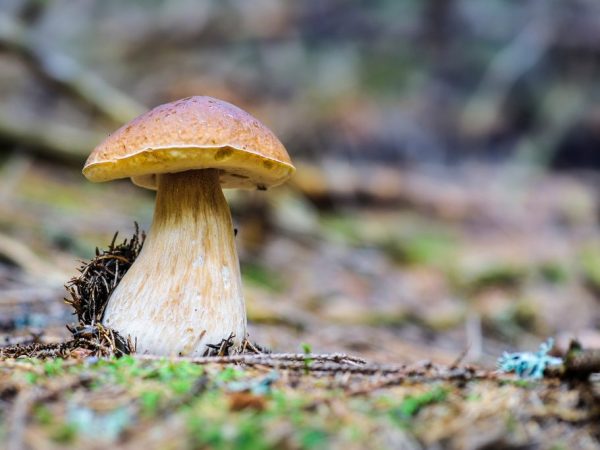
Characteristics of edible mushrooms
Photos and names of mushrooms
Differences
Sometimes poisoning occurs due to one piece of pale toadstool or red fly agaric, which fell on the table along with edible mushrooms. In order not to confuse edible and inedible mushrooms, it is necessary to understand exactly which specimens are common in the area, how they look. Only the well-known mushroom is placed in the basket.
Some varieties of edible and inedible crops are similar. Despite the similarities, they also have a number of differences.
- Appearance: the color of edible specimens is often dim, but there are exceptions. For example, a chicken mushroom has a bright yellow hat. Poison in inedible organisms repels insects. In edible specimens, however, there are most often a lot of worms and beetles. The edible varieties also have a skirt. Most poisonous ones do not have it.
- Change in color at a break (cut): edible and poisonous mushrooms are characterized by this characteristic. In edible specimens, it becomes beige or brown, while in poisonous specimens it acquires a brighter color (red, orange), or a dangerous mushroom turns blue.
- Smell: Often the edibility is determined by it. Almost all edible mushrooms have a pleasant aroma. Parasitic fungi and specimens not suitable for food have a chlorine or medicinal smell, but there are exceptions (fly agaric).
- Cap surface: Many inedible varieties have a sticky cap to the touch. It is worth avoiding those specimens that do not have a tubular layer under the cap.
- Base of the leg: in poisonous specimens, the base of the leg is almost always submerged (surrounded) by a special sac (volva) - the remainder of the common blanket.Edible mushrooms have no such formation. Also, in inedible and poisonous specimens, in addition to the volva, the base of the leg is expanded into a tuber-like, well-defined formation.
These are the main differences between edible and inedible mushrooms. Of the poisonous species on the territory of Russia, the most common are the pale grebe (green fly agaric), red fly agaric, slender pig and satanic mushroom. The pale toadstool is deadly.
If the above signs are absent, but there is no certainty that the found specimen does not contain toxic substances, you should not take it.
Types of edible mushrooms
There are different classifications of mushrooms. They are divided into categories depending on the growing area (forest, steppe), fruiting time (spring, summer, autumn, winter), structures (tubular, lamellar), etc. To recognize an edible mushroom or not, it is not necessary to know about the existence of these categories, a sufficiently accurate and complete description.
The list of edible mushrooms is huge. On the territory of Russia, boletus, mushrooms, mushrooms, boletus, boletus, boletus, chanterelles, russula, boletus and milk mushrooms are most often found.
Boletus
This mushroom is also known as "white". It owes this name to the snow-white color of the pulp. Because of their taste and rich aroma, boletus mushrooms are considered a delicacy.
Boletus has a tubular hymenophore structure. The size of the cap varies from 10 to 30 cm. In small mushrooms, the shape of the cap resembles a hemisphere. As they grow older, it straightens a little and becomes flat-rounded. The cap is covered with a matte cuticle of medium thickness, colored light brown or brown, less often dark orange. The edges of the cap are always slightly lighter than the center of the cap. After rain, it acquires a slight sheen. The fleshy flesh has a rich mushroom aroma and a dense structure.
The height of the leg varies from 10 to 25 cm. It is colored light brown, sometimes there is a slight reddish tint. At the base, the stem is slightly wider than at the junction with the cap (this is a typical shape). It resembles a barrel or cylinder in shape. The tubular layer is colored white or olive.
This species is easy to find in both coniferous and deciduous forests. Collection time is summer. Boletus is unpretentious to the climate and grows well even in the north.
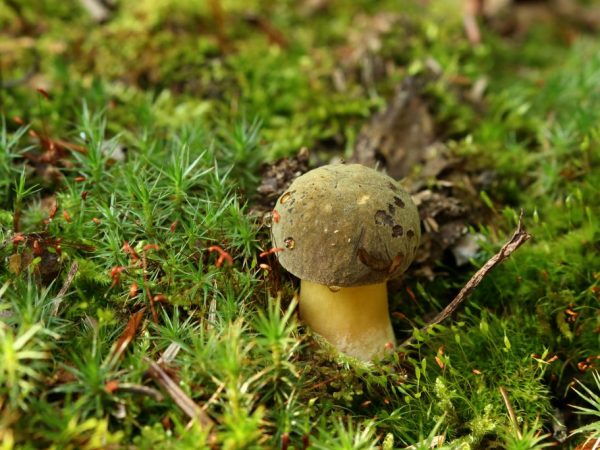
Boletus is easy to find in both coniferous and deciduous forests.
Honey mushrooms
This type of mushroom is most commonly found near stumps and trees. Honey mushrooms grow in numerous groups, which is their characteristic feature. They have a lamellar structure of the spore-bearing layer. The diameter of the cap varies between 5-10 cm. It is painted beige, honey or brown. In young specimens, the color of the cap is more intense than in older ones. Its shape also changes with age. From hemispherical, it turns into an umbrella-shaped. The surface of the skin on the cap at a young age is covered with an insignificant amount of scales, and later becomes smooth.
Irina Selyutina (Biologist):
Experienced mushroom pickers advise to collect only young mushrooms that meet all the appearance requirements, by which they clearly differ from poisonous twins:
- scales on the surface of the cap;
- "Skirt" on the leg;
- plates of cream, white or slightly yellowish color;
- calm coloration of the fruiting body.
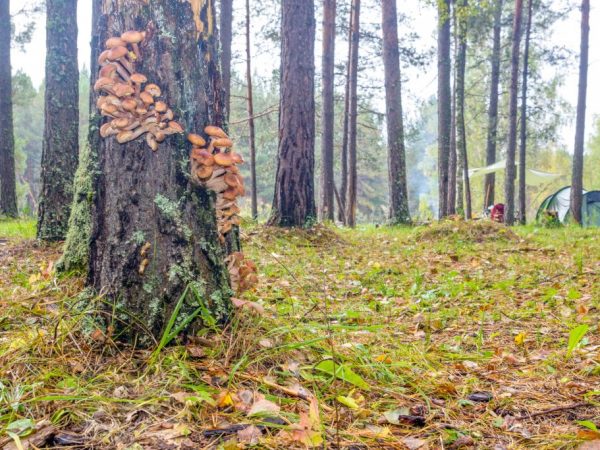
Honey mushrooms often grow on trees
The height of the thin cylindrical stem varies between 5-13 cm. The color of the flexible stem corresponds to the color of the cap. At the base of the leg, it is more saturated than in other areas. Many representatives have a filmy “skirt” on the stem - the remnant of the film that covered the hymenophore. The honey agaric gathering time is autumn.
Ryzhiki
These edible mushrooms are preferred by coniferous forests. The structure of the hymenophore (spore-bearing layer) of the fungus is lamellar. The diameter of the cap varies from 3 to 9 cm. It is painted in a soft orange color. The color of the cap corresponds to the dense flesh.In shape, it is hemispherical in young specimens, and funnel-shaped in old ones, even edges are slightly bent inward. The smooth skin covering the cap becomes sticky after rain and high humidity.
Irina Selyutina (Biologist):
When collecting mushrooms, it is advisable to carefully examine their cap not only from the top, but also from the bottom. The thing is that a specialized parasitic fungus, brick-red pequiella, often settles on the surface of the caps of the saffron milk caps. Its mycelium permeates the entire fruiting body of the host and causes a simplification of the structure of the plates - their reduction. In this case, stromas are formed on the plates, covering almost the entire underside of the caps. As a result, the plates resemble low ribs, do not develop fully (they cannot participate in the formation of spores), and sometimes are completely invisible. Mycologists call such parasite-affected mushrooms "stone" or "deaf". Collecting them is not recommended.
The mushrooms rise above the ground to a height of 3-8 cm. The fragile leg is painted in a color corresponding to the color of the cap, and becomes hollow inside with age. Sometimes there are spots of a lighter or darker shade on the leg. The first mushrooms appear in early summer. They can be found in coniferous forests.
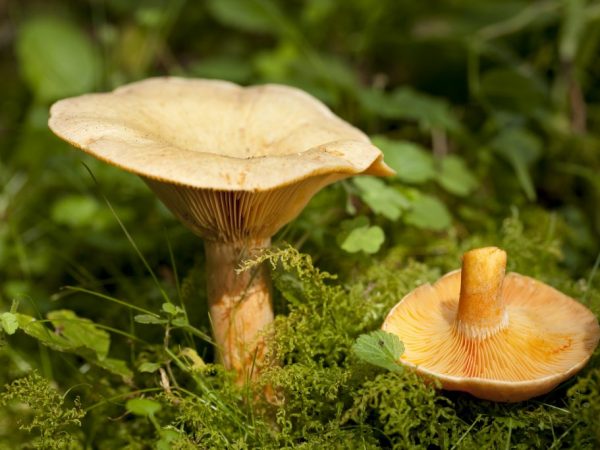
Gingerbreads grow in coniferous forests
Butterlets
Forest boletus have a tubular cap, as if covered with oil, which is their characteristic feature. Therefore, such a name arose. At a young age, the cap has a hemispherical shape, then becomes flat-rounded. The diameter of the cap varies from 7 to 15 cm. The color of the thin skin, which looks more like a film, is from light beige, reddish, chocolate or ocher shades with spots. It can be sticky or velvety to the touch. It depends on the type of boletus and the weather. Their hymenophore is tubular (spongy).
The dense, low leg (4-10 cm) has a barrel-shaped or straight shape. It is decorated with a white skirt and has a cream or light yellow color. Butterlets are harvested in mid-spring.
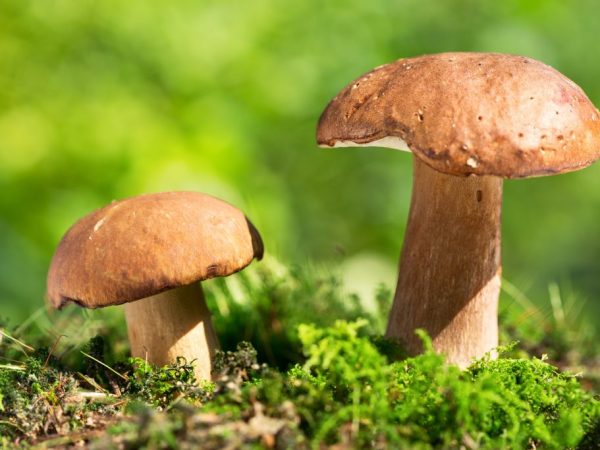
Butterlets start to be harvested in mid-spring.
Aspen boletus
Aspen boletus is popularly called aspen boletus or redhead boletus. And it owes its name to the fact that it grows next to aspens, and the color of the skin covering the cap and the color of the autumn aspen are almost identical.
The hemispherical fleshy cap with a tubular structure of the spore-bearing layer has a bright red-orange color. Its diameter varies from 5 to 30 cm. In young specimens, the shape of the cap resembles a thimble. It is difficult to remove the skin from the cap. It can be dry or velvety to the touch. The pulp is colored milky or creamy.
The leg height varies from 15 to 20 cm, which is why the boletus is clearly visible above the ground. The characteristic shape of the boletus leg is clavate. It is painted white. On the surface, there are a large number of small scales, colored brown or black. Boletus is collected in mid-summer and early autumn. They grow both in the south and in the northwest. They feel comfortable in any climatic conditions.

Aspen mushrooms are harvested in mid-summer and early autumn.
Volnushki
Waves attract not only with an unusual color, but also with a hat pattern. They prefer to grow near birches on sandy soils. The lamellar cap at a young age is hemispherical, in the old it is funnel-shaped with edges bent inward. Its diameter varies from 4 to 12 cm. The skin covering the cap is colored pinkish or pink-orange, but there are also white specimens. There are rings of various shades on the hat. They have different widths and uneven edges. The fleshy pulp is sharp in taste. The bottom of the cap (hymenophore) is light pink. Even with a white wave, the bottom of the cap has a pinkish tint.
A thin solid leg becomes hollow with age and has a length of 2 to 6 cm. It is colored light or pale pink.Waves are harvested in mixed forests or birch groves from late summer to mid-autumn.

Waves grow near birches on sandy soils
Chanterelles
This type of edible mushroom is distinguished by the external features of the cap. It is lamellar, funnel-shaped, with wavy and slightly curved edges. The diameter of the cap varies from 6 to 13 cm. The skin covering the cap is colored yellow-orange. Fleshy and dense in structure, the flesh is creamy or light yellow.
The length of the straight leg varies from 4 to 7 cm. It is painted in a color that matches the color of the cap. Rarely, the leg and cap of the chanterelle differ in color. Chanterelles are harvested in coniferous forests from late spring to late autumn.

Chanterelles are found in coniferous forests
Russula
A feature of russula is the variety of colors in which the cap is painted. There are red-yellow or reddish, light purple, crimson, white, cream and greenish, which greatly complicates the recognition of russula. The diameter of the lamellar cap varies from 5 to 17 cm. The top is hemispherical, but becomes funnel-shaped with age. The skin is thick. It is difficult to separate it from the pulp. Often the cap is covered with shallow cracks. These colorful mushrooms have a rich aroma.
The height of the light leg varies from 4 to 11 cm. It has a cylindrical shape. Sometimes at the base it is 3-4 mm thicker than at the junction with the cap. The harvest time for russula starts in July and ends in September. In nature, they are found in deciduous or mixed forests.

Russula grow in deciduous or mixed forests
Boletus
Boletus grows in birch groves. The diameter of its gray, brown or dark brown cap varies from 5 to 12 cm. In young mushrooms, its shape is spherical, because fits snugly to the leg, and in adults it resembles a hemisphere. Boletus mushrooms are tubular mushrooms and have high taste. The fleshy flesh has a dense structure. Adult mushrooms do not have a rich aroma.
The white leg, on which a large number of brown and black scales are present, tapers slightly upward. The first boletus mushrooms appear in May. Collect them until September.
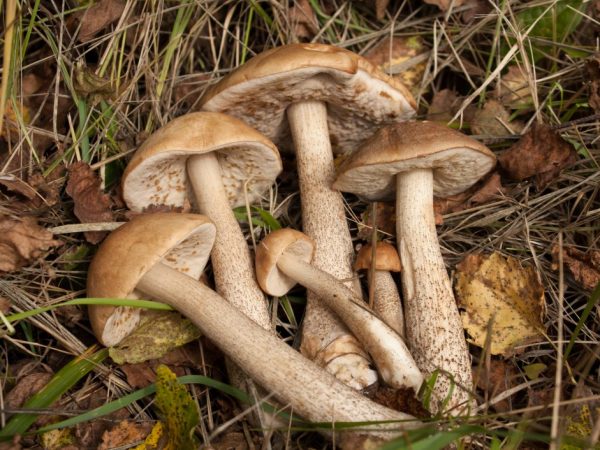
Boletus grows in birch groves
Milk mushrooms
It is easy to recognize the weight by its size. The diameter of a yellow, light gray or brown cap is sometimes 25-30 cm. Small scales are present on its surface. The flat-rounded shape turns into a funnel-shaped one with age. The edges are slightly curved inward.
The height of the leg, the color of which corresponds to the color of the cap, varies from 5 to 14 cm. It is hollow, but strong. There are notches on the leg. It is sticky to the touch. It is better to look for lactos in spruce forests or near aspens. myceliums form mushrooms from early spring to late autumn. As a place of growth, they choose mixed forests. They develop in forest litter. To see them you need to pay attention to all the "suspicious" foliage tubercles.
This list of common edible mushrooms can be expanded with the following types: kolchak, smokey (grandfather's tobacco), bear ears, raincoat or rain mushroom, fringed gallery, blues, ringed cap (they are sometimes called "Turks"). But they are much less common on the territory of Russia, which is why their description is not presented.

You need to look for milk mushrooms in spruce forests or next to aspens
Mushroom picking rules
Following simple rules, it will be possible to avoid poisoning:
- Unknown mushrooms cannot be taken, even if they have a pleasant smell and have a velvety skin.
- It is advisable for novice mushroom pickers to have a memo with them that contains a description and photographs of non-hazardous varieties. This can be a table in which dangerous species are also represented.
- Also, it will not be superfluous to look at an atlas of mushroom places or Internet services, the task of which is to determine the type of mushroom from a photo.
- At first, it is better to go to the forest with people who understand mushrooms. They will help you find mushroom glades and identify the varieties, help you understand them and teach you to distinguish edible specimens from harmful ones.
- It is best to test each mushroom by breaking it and looking for a color change.
To protect themselves from poisoning, people grow some categories of mushrooms at home. Champignons and oyster mushrooms are the most popular cultivated species. Oyster mushrooms, in which the cap is covered with a gray skin, are easier to grow.
If, after eating a mushroom dish, there are signs characteristic of food poisoning, you should immediately seek medical attention and save the mushroom dish for laboratory tests to make it easier to determine the toxin that caused the poisoning.
Conclusion
In order not to become a victim of poisoning, you should go to the forest after reading the name and description of the edible mushrooms that are most often found in your region. Take only those specimens that have all the signs of edible mushrooms (pleasant mushroom aroma, muted color, dull color at the break).
There are little-known species growing on trees (poplar, hazel, oak). Among them, there are a large number of poisonous ones, so you should not put such a find in a basket (take a picture of the find and try to determine its species when you come home). They are not considered delicacies due to their mediocre taste. The only exception is the chicken mushroom, which resembles poultry in taste and smell.














































































